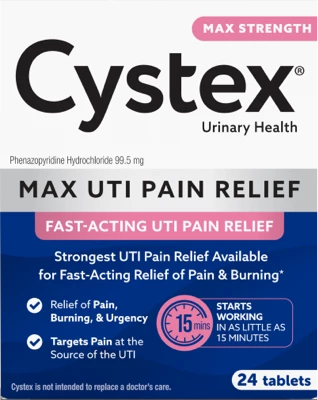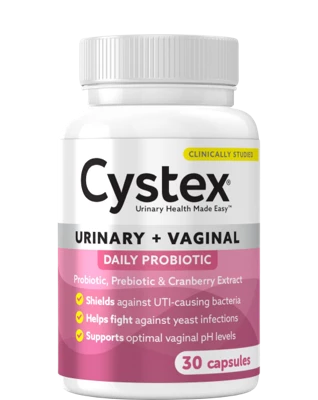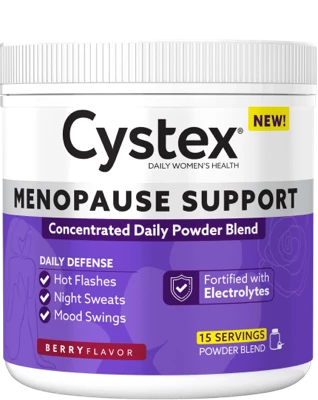-
Products
UTI Relief
Urinary & Vaginal Wellness
Menopausal Health
- UTI Resources
- Helpful Links
- Why Cystex
- Buy Now
UTI FAQs

Your top questions, answered.
A UTI is an infection in the urinary tract, such as the kidneys, bladder and urethra. Usually, the bacteria that cause a UTI enter the urethra and may travel to the bladder and kidneys. Your body often removes these bacteria, so there may not even be symptoms. But when they continue to reside in the bladder, they can cause irritation, which leads to an infection.
Source: http://www.healthline.com/health/bladder-infection#Overview1
The telltale signs and symptoms of a urinary tract infection (UTI) include frequent urination, urgency to urinate, burning, accompanied sometimes by back and side pain. If these classic urinary tract infection symptoms are present, it is important to get to a health care professional quickly.
Source: http://www.healthline.com/health/urinary-tract-infection-adults
You can help alleviate the pain with Cystex® Plus Urinary Pain Relief Tablets, a unique over-the-counter medication with a dual-action formula that combines pain relief with an antibacterial to help slow the progression of the infection. Learn more about Cystex Pain Relief & UTI Bacteria Control Tablets.
Urine is typically sterile. An infection occurs when bacteria get into the urine and begin to grow. The infection usually starts at the opening of the urethra where the urine leaves the body and moves upward into the urinary tract. Anyone can develop a UTI, but the following can increase the likelihood of developing one:
- Sexual Intercourse
- Poor personal hygiene
- People with problems emptying the bladder
- Having a urinary catheter
- Pregnancy
- Menopause
- Some forms of contraception including diaphragms
- Immobility for extended periods of time
Source: http://www.medicinenet.com/urinary_tract_infection/page2.htm
While males do experience UTIs, women are much more susceptible to them because their urethras are shorter, creating a quicker pathway for bacteria to reach the bladder. Additionally, a woman's urethral opening is directly near more sources of bacteria, such as the anus and vagina, creating the perfect environment for infection.
Source: http://familydoctor.org/familydoctor/en/diseases-conditions/urinary-tract-infections/causes-risk-factors.html
Anyone who develops any of the symptoms of a urinary tract infection needs to be evaluated by a medical professional, preferably within 24 hours. Most medical offices can test urine for infection by using a quick urine "dip and read" test. The usual treatment for both simple and complicated urinary tract infections is antibiotics. The type of antibiotic and duration of treatment depend on the circumstances.
Source: http://www.medicinenet.com/urinary_tract_infection/page2.htm
No, a urinary tract infection is a bladder infection, not a sexually transmitted disease. Sexual activity can lead to a UTI, but generally sexual partners do not need to be treated. For more information, visit the About Urinary Tract Infections page.
Sex is a common cause of UTIs in women because sexual intercourse introduces bacteria into a woman's urinary tract. During sex, the urethra comes into contact with the bacteria from the genital area and anus, allowing them to enter the urethra, the bladder, and possibly eventually the kidneys, and result in an infection. Urinary tract infections have been nicknamed "honeymoon cystitis" — cystitis is another name for an infection of the bladder — because frequent intercourse often leads to the development of a UTI. Learn more about UTIs and sex.
Source: http://www.everydayhealth.com/urinary-tract-infections/the-link-between-utis-and-sex.aspx
Cranberry juice is a great beverage, with important antioxidants that can help reduce your risk of heart disease and also strengthen your immune system, allowing your body to fight off infections. However, cranberry juice cannot cure a urinary tract infection (UTI) on its own.
Source: http://uamshealth.com/healthlibrary2/medicalmyths/cancranberryjuicecureauti/
To the contrary, the National Institute of Diabetes, Digestive and Kidney Diseases (NIDDK) reports that urinary tract infections (UTIs) account for more than 8.1million doctor visits each year, making it the second most common type of infection in the body. Moreover, the NIDDK reports that "20 percent of women who have one UTI will have another, and 30 percent of this group will have yet another,” making recurring urinary tract infections (UTIs) an issue. So while you might be prone, you’re not alone.
The drop in estrogen levels associated with symptoms of the menopausal transition can affect the urinary system. Like the vaginal wall, the urethra (the tube that drains the bladder and is used for urination) undergoes changes as estrogen levels drop. These changes in the urethra may lead to different kinds of urinary symptoms, including an increased susceptibility to urinary tract infections. If you are experiencing urinary symptoms, talk to your doctor about treatment options. Drinking plenty of fluids, avoiding overfilling of the bladder, and emptying the bladder before and after sexual intercourse can also help prevent urinary tract infections from occurring.
Source: http://www.medicinenet.com/script/main/art.asp?articlekey=77744
If your UTI returns after prescribed antibiotic treatment, you may have what’s known as a “recurrence.” Healthcare professionals consider two UTIs in six months or three in one year as “recurrent UTIs” and the situation is relatively common. Research shows that recurrent UTIs affect more than 30% of women. Such infections do not necessarily mean your antibiotic did not work if you completed the entire antibiotic course, as directed by your doctor. You may just be more prone to UTIs or perhaps you need a different type of antibiotic next time. If you suffer from recurrent UTIs, your doctor may want to do some tests to choose the most appropriate antibiotic or to make sure there isn’t another medical condition or situation contributing to increased UTI risk. Other next steps may include discussing ongoing options including a long-term antibiotic prescription (taken either daily for approximately six months or a single dose after sex or dosing when you notice symptoms), intravaginal (not oral) estrogen, self-care (including increasing fluid intake and other daily life tips), and - increasingly - supplementation with specific probiotics, vitamins, and helpful compounds found in cranberry products (proanthocyanidins or PACs).
Source: https://www.aafp.org/afp/2016/0401/p560.html, https://www.auanet.org/education/auauniversity/for-medical-students/medical-students-curriculum/medical-student-curriculum/adult-uti
If you still have questions, please contact us










